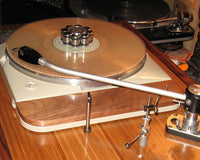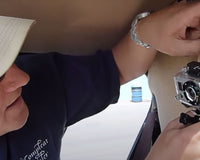Hey everyone, this is Ian here at Isolate IT Mfg. I've been one of our product application designers for the past decade and today I'm sharing a personal project that I've been working on. It's also a question that we get a lot here. How do I prevent hearing and feeling vibration or noise in my bed when I'm trying to fall asleep?
I live in a 110-year-old house and my upstairs laundry room happens to be one room over from my bedroom. There is also a ceiling fan in the room directly below my bedroom. Add in the fairly busy road in front of my home and you've got a situation that a lot of people find themselves in. I'm a pretty heavy sleeper but I do still find that I'm very sensitive to ambient vibration noise right when I'm trying to fall asleep or catch a mid-day nap on the weekends. Here is where our Isolate IT Sorbothane can help.

All those things that I listed above, washing machines, fans, road noise, etc. create vibration that can resonate through the structure of your home and then up through the legs of your bed. Even when the noise is barely audible in the room, as soon as you place your ear on your pillow, you can hear it much more clearly. That's the magic of resonance and energy transfer. As with any of our projects here at Isolate IT, the key is creating isolation through a barrier material like Sorbothane. In this case I'm isolating or "floating" my bed and mattress on a layer (technically 2 layers in this case) of Sorbothane. This flexible boundary makes it much harder for vibration energy to transfer into the bed frame and what's left is barely perceptible if you can sense it at all.
First, we've had our Silent Feet for Beds on the market for years. These were one of the trickiest products for us to develop because of a few things. First, there are a ton of different sizes and types of beds out there. Second, there are a lot of variables like frame weight, mattress weight, your weight, etc. that prevent the creation of a universal fit product. Third, bed frame manufactures have a nasty habit of somewhat randomly deciding how many legs and supports a bed should have. You'd think that the default would be 4 and it used to be. But now as more and more people are getting larger beds, there are more frames with middle legs (like mine which has 11 "legs") or no legs like these modern MALM styles from IKEA.
Normally, when I help you design an solution to your application, we take the total weight of the object to be isolated (turntable, speaker, lab equipment, etc.) and then divide it by the number of contact points (usually 4). For a bed, we've now got a much more complicated equation. Factor in if you share the bed with someone else, the weight of the frame plus the mattress (both of which can be hard to find specs on and your bathroom scale or fish/luggage scale aren't going to help you here), then divide it by the irregular number of legs. Finally, Sorbothane works best when it is evenly loaded, that means the weight is balanced equally across all the pads. If you're sleeping on one side of the bed or your partner isn't identical to you, throw equal loading out the window.
Now that I've told you all the things that make this hard, let's solve it as best as we can. First, the best place to start is still those Silent Feet for Beds (available in a 4 and 6 pack). These have been designed to be as "universal" as possible, but they still have some limitations. They provide a very thick layer of Sorbothane right where you need it under each of the bedframe legs. They also have a stiff rubber top cup to keep the pad under the leg and felt on the bottom to protect your floor. You need to install one of these under each leg of your bedframe. Don't skip any! I repeat, DO NOT TRY TO SAVE A FEW $$$ AND LEAVE ANY LEG UNSUPPORTED! This will lead to an unstable application and possibly damage your bedframe. Here is where our 4 and 6 pack options can help you. They are priced so that you can mix and match pack sizes to get to that magic number of pads to legs ratio for your bed (and yes, I needed two 6 packs for my 11 leg California King bedframe).

Now that you have one layer of isolation, you should notice some reduction in noise transferring to your bed (I found about a 50% improvement). But, for all the reasons that I listed above, we aren't aiming for a specific weight load range, because there are too many variables that aren't reasonable for us to try to control. You can if you want to, but I've already herniated one disc and I'm not trying to do that again just to weigh my mattress and bedframe.
So, here we go down the rabbit hole of further isolation. This is also where you need to get creative with the unique features and design of your bed frame. Mine has wooden crossmembers and plywood panels that support the mattress. This gives me a second space to create a flexible barrier in the setup. I added a layer of Sorbothane here by placing rectangles of 1/4" thick Isolate IT Sorbothane at 7 points (approximately 14" apart) along each of the 5 crossmembers. For this, I used a quality pair of scissors cut up strips of our 50 Duro 36"x2"x1/4" Isolate IT Sorbothane into 3-4" segments. The 3 plywood panels line up perpendicular to the crossmembers, so I made sure that each was supported on the edges and centerline.

Again, we're not aiming for perfect, just better. After placing these segments, I put the plywood panels back down making sure that none of them was in direct contact with the bedrails on the side. Any time that you have direct hard contact without Sorbothane between it, you are creating a spot for vibration to transfer. Lastly, I put the mattress back on and made the bed again. Overall, this application raised my bed by about 1.75" and I'd say that I got a 60% reduction in the noise that I can hear. That improvement still varies based on what I've got in the washing machine (bulky or small items) or how big or noisey the cars and trucks driving past are. This is a pretty typical result for using our Silent Feet for Beds given all the challenging variables that the world of beds throws at us.
Hopefully, that helps with your next project. Also, if you are trying to isolate vibration in the other direction, yes, we get that question too, this whole process works for that too. Creating a barrier with Isolate IT Sorbothane works both ways. Your downstairs neighbors will appreciate your efforts. Good luck and happy isolation!











